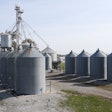The University of Illinois at Urbana-Champaign announced its plans to construct a new $13.3 million Feed Technology Complex to replace the university’s nearly 90-year-old feed mill.
The project will be funded through a public-private partnership. As part of its “Illinois Jobs Now!” capital construction program, the university will receive a $3.5 million grant from the state. The College of Agricultural, Consumer and Environmental Sciences (ACES) and the University of Illinois have earmarked $6 million for the new facility.
In addition, Chicago-based Archer Daniels Midland has also agreed to donate $1.5 million toward the project. The university will soon begin fundraising efforts in a bid to gather donations from private industry and agricultural groups.
“We would hope the feed industry values the products we produce — the research we generate, the discoveries we make and the students we train — as being important to their own commercial interests and that they’d want to engage with us in the construction and use of the mill,” explains Dr. Steven Loerch, the head of U of I’s Department of Animal Sciences.
While no definitive timeline has been set, the university is preparing to enter the design and engineering phase of the project.
The Feed Technology Complex will be relocated to the university’s South Farms district.
Strong nutrition program
Built in 1927, the ACES feed mill currently manufacturers experimental rations to support the school’s research programs, which include swine, dairy, beef, poultry and equine units. It produced 4,000 tons of feed per year.
Nutrition is one of the Animal Science Department’s “signature programs.” Fifty graduate students, 40 faculty members and 160 undergraduates use the feed manufactured in the mill. Unlike a commercial operation, the ACES feed mill manufactures small batches of up to 150 different formulations a week.
“We won’t rival K-State’s feed processing program – those guys are as good as it gets – but I do believe we have the best animal nutrition program in the country and that’s what makes us unique,” says Loerch, who assumed the U of I position in March after serving on the faculty of Ohio State University’s animal sciences department for 32 years.
The new complex will also be used for classwork in crop and animal sciences.
By-product exploration
This spring the university will break ground on its $24 million Integrated Bioprocessing Research Laboratory (IBRL), “a flexible, plug-and-play, pilot scale facility and analytical laboratory that will bring faculty, students and industry together to develop efficient and economical strategies for the production of renewable bio-based products.”
The synergy between the new feed mill and the IBRL will allow researchers to explore the potential of the by-products created from biofuel production – specifically residues and substrates — for use in livestock nutrition and feed processing, Loerch says.
“With so many crops and so many different plant varieties and hybrids out there – each with different nutrient compositions — there is much more work that needs to be done in terms of how they line up with meeting the needs of specific animals for specific purposes,” he explains. “The by-products of the grain industry are really important to the future success of biofuels, livestock and feed industries. Feed processing has a big impact on nutrient availability and digestion. Manure output represents failed digestion by the animal, thus feed processing also has environmental and waste management implications.”
The IBRL will be completed in 2016.

















